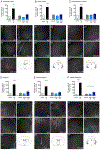Preclinical safety and efficacy of cannabidivarin for early life seizures
- PMID: 30633929
- PMCID: PMC6424614
- DOI: 10.1016/j.neuropharm.2019.01.002
Preclinical safety and efficacy of cannabidivarin for early life seizures
Abstract
A significant proportion of neonatal and childhood seizures are poorly controlled by existing anti-seizure drugs (ASDs), likely due to prominent differences in ionic homeostasis and network connectivity between the immature and mature brain. In addition to the poor efficacy of current ASDs, many induce apoptosis, impair synaptic development, and produce behavioral deficits when given during early postnatal development. There is growing interest in new targets, such as cannabidiol (CBD) and its propyl analog cannabidivarin (CBDV) for early life indications. While CBD was recently approved for treatment of refractory childhood epilepsies, little is known about the efficacy or safety of CBDV. Here, we addressed this gap through a systematic evaluation of CBDV against multiple seizure models in postnatal day (P) 10 and 20 animals. We also evaluated the impact of CBDV on acute neurotoxicity in immature rats. CBDV (50-200 mg/kg) displayed an age and model-specific profile of anticonvulsant action. In P10 rats, CBDV suppressed seizures only in the pentylenetetrazole model. In P20 rats, CBDV suppressed seizures in the pentylenetetrazole, DMCM, and maximal electroshock models. Between P10 and P20, we identified significant increases in mRNA expression of TRPV1 in multiple brain regions; when CBDV was tested in P20 TRPV1 knockout mice, anticonvulsant effects were attenuated. Finally, CBDV treatment generally avoided induction of neuronal degeneration in immature rats. Together, the efficacy and safety profile of CBDV suggest it may have therapeutic value for early life seizures.
Keywords: Cannabidivarin; Cannabinoid; Cell death; Neonatal; Seizure.
Copyright © 2019 Elsevier Ltd. All rights reserved.
Figures








References
-
- Alvarez FJ, Lafuente H, Rey-Santano MC, Mielgo VE, Gastiasoro E, Rueda M, Pertwee RG, Castillo AI, Romero J, Martínez-Orgado J, 2008. Neuroprotective effects of the nonpsychoactive cannabinoid cannabidiol in hypoxic-ischemic newborn piglets. Pediatr. Res 64, 653–658. 10.1203/PDR.0b013e318186e5dd - DOI - PubMed
-
- Bittigau P, Sifringer M, Genz K, Reith E, Pospischil D, Govindarajalu S, Dzietko M, Pesditschek S, Mai I, Dikranian K, Olney JW, Ikonomidou C, 2002. Antiepileptic drugs and apoptotic neurodegeneration in the developing brain. Proceedings of the National Academy of Sciences 99, 15089–15094. 10.1073/pnas.222550499 - DOI - PMC - PubMed
Publication types
MeSH terms
Substances
Grants and funding
LinkOut - more resources
Full Text Sources
Other Literature Sources
Medical
Miscellaneous

